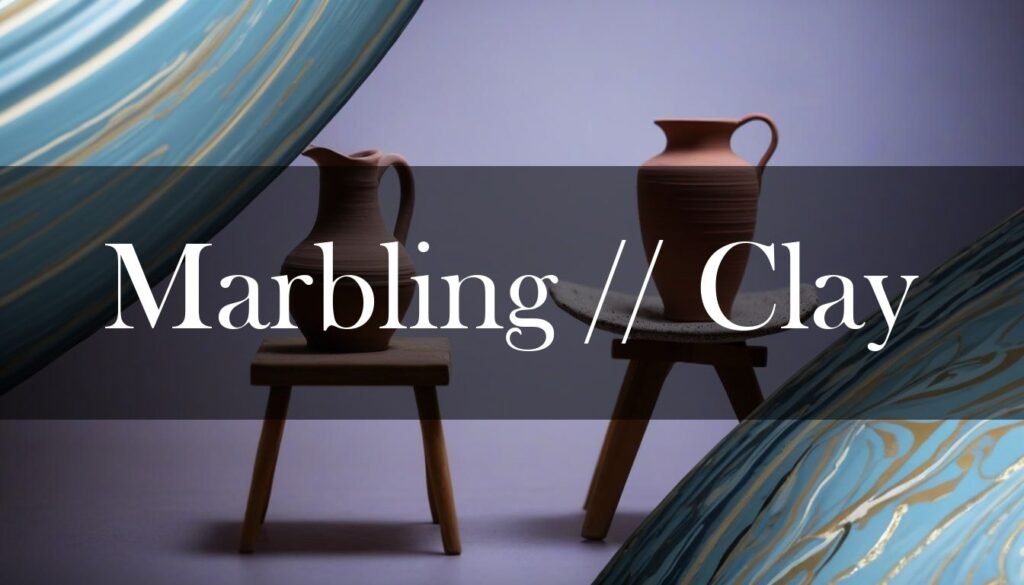Marbling with colored clays is a pottery technique that invites a bit of magic into your studio, allowing you to create swirling, organic patterns reminiscent of natural marble. This mesmerizing method involves blending different clay colors together, resulting in unique, one-of-a-kind pieces that showcase the harmonious dance of color and form. The beauty of marbling lies in its unpredictability and the endless possibilities it offers for creative expression.
The art of marbling clay is steeped in history, with evidence of its use dating back to ancient civilizations. Egyptians and Chinese artisans employed early forms of marbling, and the Romans later adopted the technique. In England, it evolved into what was known as agateware, celebrated for its decorative effects achieved through layering multiple colored clays. In Japan, this art form reached new heights with techniques like nerikomi and neriage, where colored clays are meticulously layered and manipulated to craft intricate patterns that run through the entire piece. You can explore similar concepts in depth in Agateware: Marbling Magic in Clay
There are several ways to achieve a marbled effect. One popular method involves marbling directly on the pottery wheel. First, you create colored clays by mixing pigments into your base clay. Then, you layer these colored clays and throw them on the wheel, allowing the spinning motion to blend the colors into mesmerizing patterns. Once the piece is shaped, you can carefully remove a layer of slip to reveal the marbled design beneath. Alternatively, you can hand-build with marbled slabs. This involves layering different colored clay slabs, compressing them, and then rolling them together to achieve the desired marbled effect, without the need for a wheel. A fun technique here is the “stack and slam,” where you stack colored slabs, compress them forcefully, and then roll them out. For surface decoration, you can use colored slips or underglazes applied to leather-hard clay, swirling and blending them to create intricate patterns that come to life during the bisque firing. Another fascinating technique is nerikomi, originating from Japan, where you layer different colored clays to form a block, slice it to reveal patterned cross-sections, and then use these slices to construct vessels or decorative pieces. This technique is discussed further in Nerikomi Neriage: A Colorful Clay Journey.
Marbling techniques offer a diverse range of approaches, from wheel-thrown methods to hand-built slabs, each providing unique avenues for blending colors and creating intricate patterns.
When it comes to choosing the right clay, polymer clay stands out due to its versatility and extensive color range. Sculpey Premo™ is a great choice, known for its satiny finish and blendable colors, while Fimo Professional is favored for its firmness and vibrant hues, perfect for intricate designs. Feel free to experiment with specialty clays like metallic, translucent, or glitter clays to add unique touches to your marbled creations. To prevent your pieces from distorting, remember to roll your clay slabs in multiple directions to evenly distribute stress, compress the clay surface with a rib tool, and minimize handling to avoid introducing unwanted stress. Ensure your clay has a uniform moisture content and dry your pieces slowly and evenly, using absorbent boards like plywood or plasterboard to help regulate moisture.
- Roll clay slabs in multiple directions to evenly distribute stress.
- Compress the clay surface with a rib tool.
- Minimize handling to avoid introducing unwanted stress.
- Ensure your clay has a uniform moisture content.
- Dry your pieces slowly and evenly, using absorbent boards to help regulate moisture.
Color selection is key to a successful marbled effect. Classic black and white offers a timeless, stone-like appearance, while soft pastels create a soothing, delicate pattern. Earth tones can mimic natural stones like sandstone, and vibrant, contrasting colors add dynamic energy. For a luxurious touch, consider incorporating metallic accents like gold, silver, or copper. Experiment with twisting and folding, layering and slicing, or even chopping and reassembling your clay to achieve diverse marbled effects. Once your piece is complete, sanding and buffing will enhance its surface, and sealing it with a water-based polyurethane varnish or a paste wax will protect and add the desired finish. Remember, the most important thing is to have fun and embrace the unpredictable beauty of marbling.





